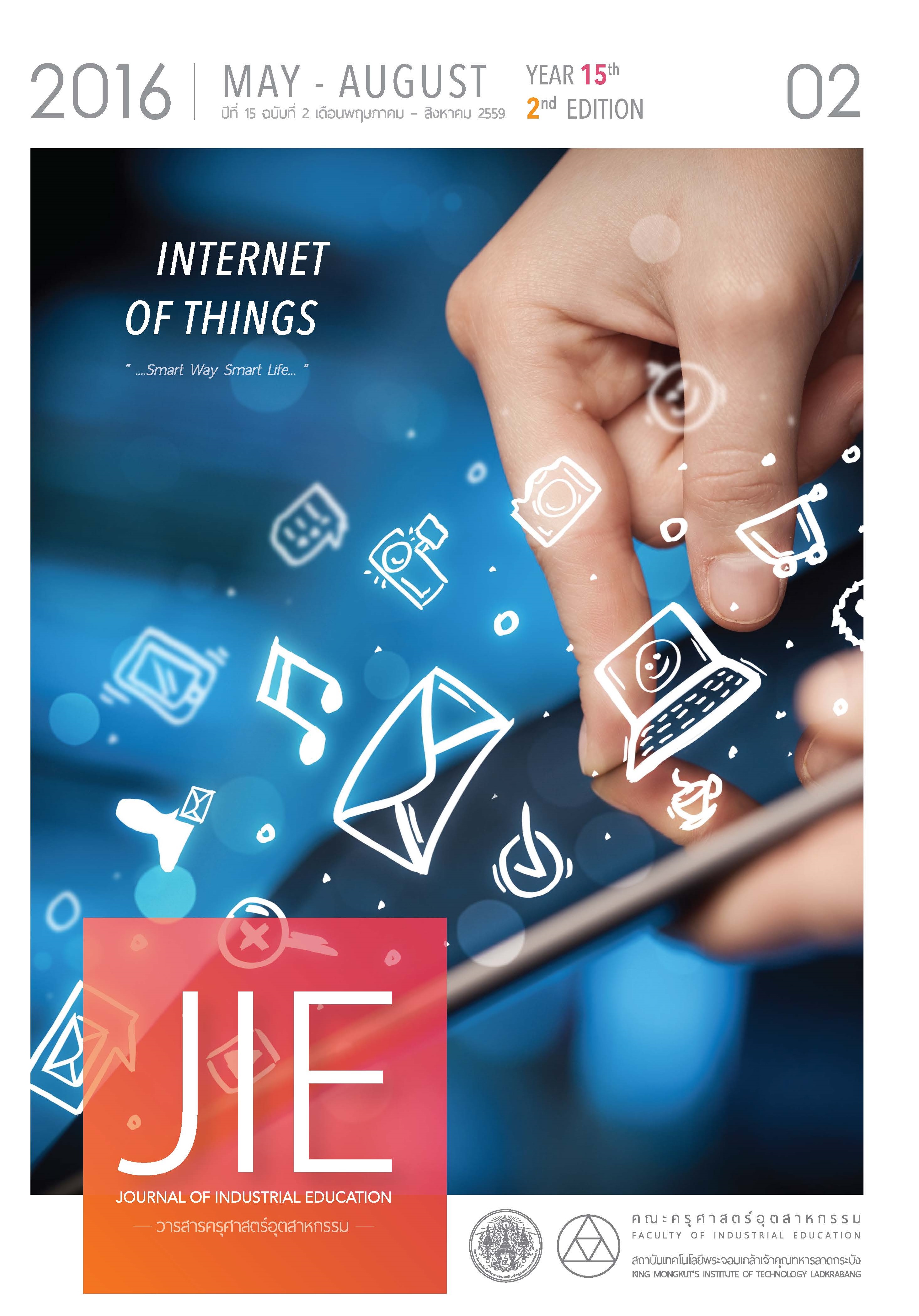A DEVELOPMENT OF WEB-BASED INSTRUCTION VIA STEM EDUCATION ACTIVITIES ON PROGRAM APPLICATION FOR GRADE 9 STUDENTS
Main Article Content
Abstract
The main purposes of this research include developing the quality and efficiency of web-based instruction about an application development for 9th grade students via STEM education activities as well as comparing the learning achievement between the students who are learning through web-based instruction via STEM education activities and regularly-instructed group. The samples of the study are 30 students per group in second semester of academic year of 2015 from Thepha School, Songkla. Group 1 is the group of students who are learning through web-based instruction via STEM education activities and group 2 is the group of students who apply the normal learning. All samples are selected by Cluster Random Sampling Method. The research tools are comprised of web-based instruction lessons, quality evaluation questionnaire of web-based instruction and achievement test. The Index of Consistency (IOC) was reported between 0.67-1.00 while the level of difficulty was between 0.27-0.80. The degree of discrimination was between 0.20-0.53 while the test reliability was at 0.82. The data were statistically analyzed by using mean, standard deviation and independent sample t-test.
The results showed that the total quality of web-based instruction via STEM education activities was at very good level ( = 4.54, S = 0.54) with the quality of content at very good level (
= 4.58, S = 0.58) and the quality of media production at good level (
= 4.48, S = 0.50). It is also found that the efficiency of web-based instruction lessons (E1/E2) was 82.60/80.15. Furthermore, it is revealed that the learning efficiency of the student learning through web-based instruction via STEM education activities was significantly better than those of the regularly-instructed group at significant level of 0.05.
Article Details
"The opinions and contents including the words in papers are responsibility by the authors."
"ข้อคิดเห็น เนื้อหา รวมทั้งการใช้ภาษาในบทความถือเป็นความรับผิดชอบของผู้เขียน"
References
[2] ทวีศักดิ์ กออนันตกูล. 2545. นโยบาย e-Education. กรุงเทพฯ: ศูนย์เทคโนโลยีอิเล็กทรอนิกส์และคอมพิวเตอร์แห่งชาติ.
[3] ถนอมพร เลาหจรัสแสง. 2544. การสอนบนเว็บ (Web-Based Instruction) นวัตกรรมเพื่อคุณภาพการเรียนการสอน. วารสาร ศึกษาศาสตร์สาร. 28(1) น. 87-94.
[4] อภิสิทธิ์ ธงไชย และคณะ. 2555. สรุปการบรรยายพิเศษ เรื่อง Science, Technology, Engineering and Mathematics Education : Preparing students for the 21st Century. ค้นเมื่อวันที่ 5 มีนาคม 2557, จาก https://designtechnology.ipst.ac.th/uploads/STEMeducation.pdf
[5] ฝ่ายวิชาการโรงเรียนเทพา. 2557. ผลสัมฤทธิ์ทางการเรียนวิชาเทคโนโลยีสารสนเทศ.[ออนไลน์]. เข้าถึงได้จาก: https://www.thepha.ac.th. (วันที่ค้นข้อมูล: 5 มีนาคม 2557).
[6] อภิสิทธิ์ ธงไชย. 2556. เทคโนโลยีและวิศวกรรมคืออะไรในสะเต็มศึกษา. สถาบันส่งเสริมการสอนวิทยาศาสตร์และ เทคโนโลยี (สสวท.), 42(185), น.35-37.
[7] Seel, B. B. and Richey, R. C. 1994. Instructional Technology: The Definition and Domains of the field. Washington, D.C.: Association for Educational Communications and Technology.
[8] วรนุช ตุนทกิจ. 2553. การตรวจสอบแผนการจัดการเรียนรู้. ค้นเมื่อวันที่ 5 มีนาคม 2557, จาก https://www.km.skn.go.th/? name=research&file=readresearch&id=5
[9] ไพโรจน์ ตีรณธนากุล ไพบูลย์ เกียรติโกมลและเสกสรร แย้มพินิจ. 2546. การออกแบบและการผลิตบทเรียนคอมพิวเตอร์การ สอน. กรุงเทพฯ:ศูนย์สื่อเสริมกรุงเทพฯ.
[10] ชัยยงค์ พรหมวงศ์. และคณะ. 2542.ระบบสื่อสารการสอน. กรุงเทพฯ: โรงพิมพ์จุฬาลงกรณ์มหาวิทยาลัย.
[11] Bloom, B.S. 1956. Taxonomy of Educationalobjectives. New York: Longman.
[12] มนต์ชัย เทียนทอง. 2548. การออกแบบและพัฒนาคอร์สแวร์สำหรับบทเรียนคอมพิวเตอร์ช่วยสอน. กรุงเทพฯ: ศูนย์ผลิตตำรา เรียนสถาบันเทคโนโลยีพระจอมเกล้าพระนครเหนือ.
[13] จิรภาภรณ์ วงศ์กาญจนฉัตร. 2557. บทเรียนผ่านเครือข่ายอินเทอร์เน็ต เรื่องพระราชบัญญัติว่าด้วยการกระทำความผิดเกี่ยวกับ คอมพิวเตอร์ พ.ศ. 2550 สำหรับนักเรียนระดับประกาศนียบัตรวิชาชีพ. วิทยานิพนธ์วิทยาศาสตรมหาบัณฑิตสาขาวิชาการ ศึกษาวิทยาศาสตร์ (คอมพิวเตอร์) คณะครุศาสตร์อุตสาหกรรม สถาบันเทคโนโลยีพระจอมเกล้าคุณทหารลาดกระบัง.
Wongkanjanachut, J. 2014. Web-based Instruction on Act on computer-Related Offences be 2550. Thesis in Science, Science Education (Computer), Industrial Education, King Mongkut’s Institute of Technology Ladkrabang.
[14] จีรนันท์ ปัญญาเหลือ ฉันทนา วิริยเวชกุล และอรรถพร ฤทธิเกิด. 2558. บทเรียนบนเครือข่ายอินเทอร์เน็ต เรื่อง เรือ มอันเร.วารสารครุศาสตร์อุตสาหกรรม, 14(1), น. 191-197.
Panyalue, J., Viriyavejakul, C. and Ridhikerd, A. 2015. Web-Base Instruction Based on Reamaunre Dance. Journal of Industrial Education. 14(1), p. 191-197.
[15] Ausubel, D. P., Novak, J. D. and Hanesian, H. 1978. Educational Psychology: A Cognitive View. 2nd ed. New York:Holt, Rinehart and Winston.
[16] พลศักดิ์ แสงพรมศรี. 2558. การเปรียบเทียบผลสัมฤทธิ์ทางการเรียน ทักษะกระบวนการทางวิทยาศาสตร์ขั้นบูรณาการ และ เจตคติต่อการเรียนวิชาเคมี ของนักเรียนชั้นมัธยมศึกษาปีที่ 5 ที่ได้รับการจัดการเรียนรู้สะเต็มศึกษากับแบบปกติ.วิทยานิพนธ์ วิทยาศาสตรมหาบัณฑิต สาขาเคมีศึกษา มหาวิทยาลัยมหาสารคาม.
Saengpromsri, P. 2015. Comparisons of learning achievement, and attitude towards chemistry learning for Matthayomsueksa 5 student between STEM education and conventional methods. Thesis in Science, Chemistry Education, Mahasarakham University.

